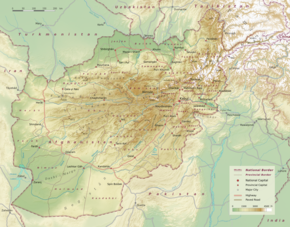 [August 16, 2021: The U.S./NATO withdrawal and Taliban takeover of Afghanistan have put an end to this issue, though it remains of historical interest.]
[August 16, 2021: The U.S./NATO withdrawal and Taliban takeover of Afghanistan have put an end to this issue, though it remains of historical interest.]
[January 31, 2018: This article was published in 2008. While some of the details have been overtaken by events, the main thrust of the argument has changed little. Keeping troops in Afghanistan for 16 years by now, with no end in sight, seems so palpably contrary to American interests that we must ask whether the U.S. Government has an unstated motive. By far the most plausible such motive is that the Israel Lobby wants us to keep our troops in Afghanistan to put pressure on Iran and to provide bases in the event of a war against Iran. In turn, the power of the Israel Lobby and the consequent possibility of war against Iran motivate the U.S. military to seek to remain. The cost of the war has climbed well beyond $1 trillion. Thousands of American soldiers have been needlessly killed, and thousands more maimed.]
[2008] According to media reports, American commanders in Afghanistan are asking for 5-10,000 troops above the 4,000 approved for deployment and the 10,500-12,000 already requested–for a total of up to 26,000. 32,000 are currently in Afghanistan. Overshadowed by the elections and global financial crisis, this proposed major escalation is moving ahead with little debate. And it is not a temporary ”surge”; the generals are seeking these new troop levels for the duration of the war, however many years that may involve.
Before we make this move, a weighing of pros and cons would appear to be in order.
The arguments for:
1. Fueled by $100 million per year raked off from the opium trade, the Taliban have carried out some 30 percent more attacks than in 2007, and they have become active in the environs of Kabul. Boosting troop numbers can help blunt this Taliban offensive and enable American, International Security Assistance Force (ISAF), and Afghan government forces to regain the initiative. Helicopters, surveillance drones, military police, and other specialized troops are sorely needed, American commanders say.
2. The Afghan army and police are too weak to handle the situation, while NATO partners are reluctant to boost their commitments. So sending more U.S. troops looks like the only option.
3. Instability in Pakistan and the need to combat al Qaeda make it essential to maintain a strong U.S. presence in the region.
Arguments against:
1. The United States and the world are going through the biggest financial crisis in 75 years, and we do not yet know how it will play out. Signs of an impending recession are everywhere. Prudence dictates that we refrain from making new investments of troops, equipment, and money until the uncertainty passes.
2. Every foreign soldier who enters Afghanistan provides one more incentive for Afghans to join the insurgency against the foreigners. The Afghans have a track record of driving out foreign occupiers. The presence of American and allied troops combating a religion-based insurgency (of course, also a narco-insurgency) in a Muslim country is a standing provocation to many Muslims worldwide, so fighting this war loses good will and gives young Muslims a reason to join anti-American groups.
3. The real threat to the United States is al Qaeda, not the Taliban; and al Qaeda is in Pakistan, not Afghanistan. So we are fighting against the wrong enemy and in the wrong country. We need to pressure the Pakistanis to root out al Qaeda.
4. Plenty of Afghans hate the Taliban. We could withdraw and let the two sides fight it out, perhaps lending air support to the anti-Taliban forces. In 2001 the Northern Alliance, with the assistance of the U.S. Air Force, swiftly defeated the Taliban, who were much more dominant than they are now. Of course, this option accepts the possibility of the resurgence of warlords and the decline of liberal democracy in Afghanistan, though other outcomes could emerge.
So there are arguments on both sides. Even as one recognizes the power of the arguments against escalation, one must grant the validity of American generals’ desire to obtain the troops needed to fight the war as it is presently conceived.
The future surely holds surprises. Perhaps the current efforts by the Saudis and others to broker a settlement between the Afghan Government and the Taliban will work. Perhaps the global financial crisis will lead to a sharp drop-off in demand for opium, thereby cutting the Taliban’s revenue and forcing them to curtail operations. Or the Government of Afghanistan, riddled with corruption, may implode, leaving the U.S. and its allies defending the non-Taliban parts of the country as they waver between warlordism and chaos.
So uncertainty about the future of Afghanistan’s political system runs parallel to uncertainty about the global financial crisis and its economic consequences. On balance, and in such circumstances, it seems wise to refrain from escalation, at a minimum until we know better what to expect.
Afghanistan is on the other side of the world from the United States, and its culture and history may destine it to a very different fate than we might wish. The arguments for freezing plans to escalate in reality appear to constitute a telling case for withdrawal.
*****
Kenneth J. Dillon is an historian who writes on science, medicine, and history. See the biosketch at About Us. For detective work on ancient and modern history, see his The Knowable Past (Washington, D.C.: Scientia Press, 2018).
